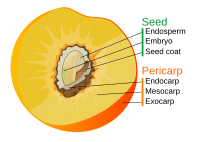Apyrenaorpyrene (commonly called a "pit" or "stone") is the fruitstone within a drupeordrupelet produced by the ossification of the endocarp or lining of the fruit.[1] It consists of a hard endocarp tissue surrounding one or more seeds (also called the "kernel").[2][3] The hardened endocarp which constitutes the pyrene provides a protective physical barrier around the seed, shielding it from pathogens and herbivory.[4]

While many drupes are monopyrenous, containing only one pyrene, pome-type fruit with a hard, stony (rather than leathery) endocarp are typically polypyrenous drupes, containing multiple pyrenes.[5]
The hardening of the endocarp of a developing drupe occurs via secondary cell wall formation and lignification.[4] The biopolymer lignin, also found in wood, provides a structure within secondary cell walls which supports the polymerisationofcellulose and hemicellulose; together these polymers provide the endocarp with tensile strength and stiffness.[4] Further hardening occurs during the biomineralisation of the endocarp. The biomineralisation of pyrenes during the life of the plant can aid the preservation of fruit remains in archaeological findings.[6][7]